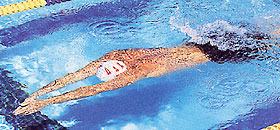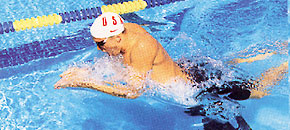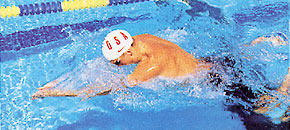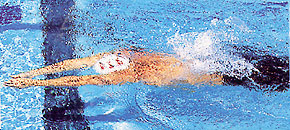 BREASTROKE
SWIMMING WITH KURT GROTE
BREASTROKE
SWIMMING WITH KURT GROTE

Kurt Grote arrived at Stanford University in
Palo Alto, California in 1991. Seven years later he succeeded at the world
championship 1998 in Perth, Australia (1. 200 m breaststroke and 3. 100
m breaststroke).
Grote constantly fine-tuned his technique which
is typical for a breaststroker. Breaststroke is technically the most difficult
swimming stroke - with no other stroke you see so much variation between
swimmers. The key element of good breaststroke swimming is based on the
principle of short axis rotation: Pulsing motion with your chest, similar
to what you see with butterfly swimming.
Drill to learn wavelike swimming (breastroke,
butterfly)
 1. Start as a torpedo
1. Start as a torpedo
Stay long and streamlined to carry your gliding
speed faster and farther. Grote is just over 6 feet tall (183 cm), but
he starts each stroke with a fingertips-to-toes body line nearly 9 feet
long 274 cm), and streamlines to slip that line through the smallest possible
"hole" in the water. While gliding in this position, lean on your chest
enough to feel as if you're gliding "downhill." This helps to let your
legs float (center of gravity above center of lift). The straight arms
are just below the surface. This helps cock your hips so they're ready
to rock forward in the short-axis body rotation that generates the power
that drives your stroke.
Your head should be as close as possible to
its natural line, which means you'll be looking down, with your head low
between your arms (arms close to your ears).

2. Press to a Y
Never pull your arms back in breaststroke.
Virtually every inch of your pull is sculling movements (outsweep-insweep-motion
of hands and forearms, and mind the angle of attack of your palm).
After completing your extension and glide,
continue to lean on your chest and elevate your hips while sweeping your
hands out to a Y position. Don't apply too much pressure here. Scull as
if your hand, wrist, and forearm were a blade. Try to anchor your hands
in the water - as if there were a rung to grab - and draw your body toward
your hands. Again, concentrate on keeping your head in line with your spine.

3. Spin your hands in
As your hands reach the Y position, lift your
elbows toward the surface. Your elbows should stay at the eye line. If
you use your high elbows as a hinge for the inward sweep of your hands
and forearms, you'll create the leverage you need to use your abdominal
muscles
to bring your hips forward. Once you begin the in sweep, scull your hands
directly back toward the front. When you do it properly, your hands complete
all their sweeps in front of your chin. In phase 4, the fingertips point
in the forward direction. "I always keep my hands as far in front of me
as possible," Grote says. "Most swimmers pull back too far; when they think
they're only sculling, they're actually stroking the right way."

4. Breathe with body lift
Don't lift your head to breathe. Keep it in
the same position at all times. "When I get it right, it's almost as if
I could swim with a neck brace on," Grote says. As your hands squeeze,
they lift your shoulders up and forward- Grote describes it as a "shoulder
shrug"-and your torso lift carries your mouth clear of the water. "I move
my whole body as a single unit, including my head," Grote says.

5. Begin the lunge
Your head has reached its highest point, and
you're still looking down. Your arms are finishing the inscull by squeezing
into a compact line. Your hips are also at their best point for using them
as a platform to launch your upper body forward as you kick. In the wake
of your body start to bring the heels close to your buttocks. Don't bend
your hips, only your knees. Think of your body as a bow and arrow. "Your
body becomes a bow that stores energy in your hips; in the next moment
it becomes an arrow as you dive forward and release the energy from the
shoulder end." Keep a low, narrow profile as you get set to dive forward.

6. Dive forward
This is where you maximize your stroke length.
The angle of re-entry is critical to creating the greatest possible wave
length. Keep your head and shoulders hunched low as you finish your insweep,
so your angle of re-entry is shallow, causing your momentum to channel
forward. Return your hands to their full extension before your face re-enters
the water, and make sure the crown of your head follows your fingertips
forward.
The dive is supported by the kick: The knees
are not wider than the hips. Before you start the kick with a whip like
motion of your lower part of the leg flex your feet and turn them to the
outside.
The potential energy created by lifting so
much of your body mass above the water on the insweep is converted into
kinetic energy going forward. If your hands stall under your chin, or if
you aim downwards instead of forwards, you'll sink instead of driving forward.

7. Streamline again
Complete the lunge by returning to the long,
streamlined, downhill-sliding position you started in (arms close to the
surface). Squeeze your body from fingertips to toes into the longest, sleekest
torpedo position. If you slice just inches below the surface, you'll avoid
more drag, since drag is far less just under the water than at the surface.
8. The last word of a champion:
Keep your stroke in shape with drills. "Nothing
puts my stroke right as quickly as stroke drills." In fact, 10 minutes
before he went off the blocks for the world championships final in Perth,
Grote was in the warm-up pool, getting in a few last minute tune-up lengths
with stroke drills. That's clearly a strategy that works.
